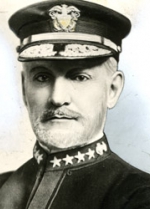Adm. William S. Sims

A native of Canada, a graduate of the U.S. Naval Academy and a two-time president of the Naval War College, Sims received The American Legion's Distinguished Service Medal in 1930. The Legion's National Executive Committee called him "a man whose leadership, whose courage and whose efficient service was most vital to our military success in the World War."
A decorated war hero, Sims already had a long list of accomplishments, including several honorary doctorates. The Distinguished Service Medal was given "as a tribute, as an expression from his comrades of the Great War, from those whom he commanded in 1917 and 1918, and from the many others who served in different branches of the armed services."
Three Navy destroyers have borne Sims' name. President Theodore Roosevelt selected him as his naval aide. And the U.S. Postal Service has added his image to a 44-cent stamp that is part of a 2010 Distinguished Sailors collection. In its tribute to Sims, the Postal Service refers to the commander of U.S. naval forces in European waters during World War I as "an outspoken reformer and innovator who helped shape the Navy into a modern fighting force."
A key moment came in 1901, when Sims bypassed his superiors and complained directly to Roosevelt about "the extreme danger of the present, very inefficient condition of the Navy." Instead of reprimand, Sims ended up in a key training role as inspector of target practice in the Navy's Bureau of Navigation from 1902 to 1909.
After the war, Sims returned to the Naval War College as president until his retirement in 1922. During that time, he won the Pulitzer Prize for writing "Victory at Sea."
Naval reform continued to be a focus of Sims' writing and speaking roles until his death in 1936 in Boston, at 77.
